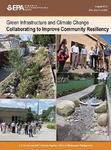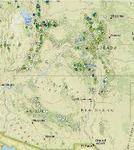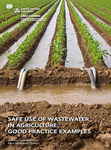Aquacrop-OS
UN Food and Agriculture Organization 2017 http://aquacropos.com/

Image

EPA Green Infrastructure and Climate Change Case Study Report
Image

 The four cities of Albuquerque, Grand Rapids, Los Angeles, and New Orleans participated in 2015 in a U.S. Environmental Protection Agency program designed to explore how green infrastructure could help them become more resilient to climate change. The EPA organized intensive planning sessions in which representatives of each city from a variety of disciplines worked with a set of concepts that guided their planning. These concepts included identifying the multiple benefits of green infrastructure practices; collaborating across city agencies to maximize benefits; unifying solutions across multiple disciplines; and achieving efficiencies in project implementation. Each city focused on their most pressing climate change issues given the level of green infrastructure they had already implemented. Lessons learned and recommendations are summarized in the publication “Green Infrastructure and Climate Change Collaborating to Improve Community Resiliency,” which is intended to serve as a guide for communities wanting to prepare for and manage the effects of climate change.
The four cities of Albuquerque, Grand Rapids, Los Angeles, and New Orleans participated in 2015 in a U.S. Environmental Protection Agency program designed to explore how green infrastructure could help them become more resilient to climate change. The EPA organized intensive planning sessions in which representatives of each city from a variety of disciplines worked with a set of concepts that guided their planning. These concepts included identifying the multiple benefits of green infrastructure practices; collaborating across city agencies to maximize benefits; unifying solutions across multiple disciplines; and achieving efficiencies in project implementation. Each city focused on their most pressing climate change issues given the level of green infrastructure they had already implemented. Lessons learned and recommendations are summarized in the publication “Green Infrastructure and Climate Change Collaborating to Improve Community Resiliency,” which is intended to serve as a guide for communities wanting to prepare for and manage the effects of climate change.National Water and Climate Center Interactive Map 3.0
Image

 The NRCS National Water and Climate Center has released a Beta version of an interactive map displaying current and historical measurements for snow, rain, and streamflow for the western United States. New features include more detailed and in-depth analyses of seasonal peak snowpack. The map reveals regional trends in snow water equivalent and snow depth. Clicking on a station displays information about the station type and location, as well as statistics on most recent values and values over the life of the station. Users are encouraged to evaluate the map features during the Beta testing phase and provide feedback.
The NRCS National Water and Climate Center has released a Beta version of an interactive map displaying current and historical measurements for snow, rain, and streamflow for the western United States. New features include more detailed and in-depth analyses of seasonal peak snowpack. The map reveals regional trends in snow water equivalent and snow depth. Clicking on a station displays information about the station type and location, as well as statistics on most recent values and values over the life of the station. Users are encouraged to evaluate the map features during the Beta testing phase and provide feedback.Safe Use of Wastewater in Agriculture: Good Practice Examples
Image

United Nations University Institute for Integrated Management of Material Fluxes and of Resources, 2017
 The United Nations University Institute for Integrated Management of Material Fluxes and of Resources (UNU-FLORES) published Safe Use of Wastewater in Agriculture: Good Practice Examples, a book-length collection of case studies. This publication aims to address the technical, institutional, and policy challenges of safe wastewater reuse, as well as providing a better understanding of its opportunities and potential risks. Wastewater has been recognized as a crucial resource for future water security. However, many developing countries and countries in transition lack the necessary scientific criteria for ensuring safe reuse. In response to this need, the UNU-FLORES identified case studies from around the world exemplifying the practice of wastewater use in agriculture across the globe. These cases were discussed at a workshop attended by representatives from 15 countries in Lima, Peru, in February 2016. The resulting book includes 17 case studies selected from Latin America, Asia, and Africa addressing three different dimensions of the topic: Technological Advances, Health and Environmental Aspects, and Policy and Implementation Issues. The new book is a resource for those interested in learning from existing good practice on using wastewater in agriculture.
The United Nations University Institute for Integrated Management of Material Fluxes and of Resources (UNU-FLORES) published Safe Use of Wastewater in Agriculture: Good Practice Examples, a book-length collection of case studies. This publication aims to address the technical, institutional, and policy challenges of safe wastewater reuse, as well as providing a better understanding of its opportunities and potential risks. Wastewater has been recognized as a crucial resource for future water security. However, many developing countries and countries in transition lack the necessary scientific criteria for ensuring safe reuse. In response to this need, the UNU-FLORES identified case studies from around the world exemplifying the practice of wastewater use in agriculture across the globe. These cases were discussed at a workshop attended by representatives from 15 countries in Lima, Peru, in February 2016. The resulting book includes 17 case studies selected from Latin America, Asia, and Africa addressing three different dimensions of the topic: Technological Advances, Health and Environmental Aspects, and Policy and Implementation Issues. The new book is a resource for those interested in learning from existing good practice on using wastewater in agriculture.

